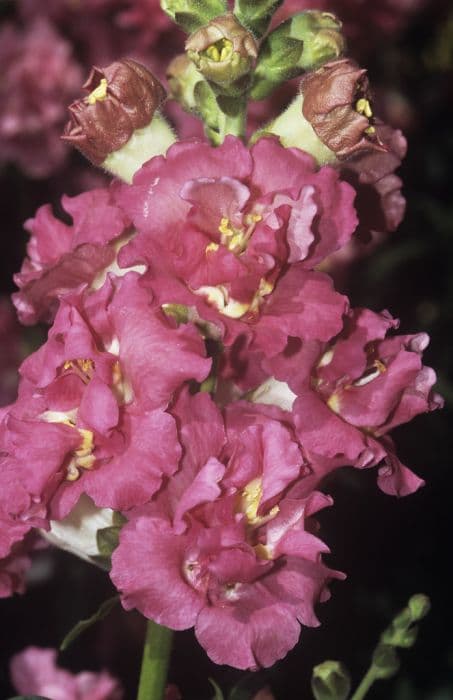Foxglove Digitalis 'Spice Island'

ABOUT
The Digitalis 'Spice Island' plant, commonly known as the Foxglove 'Spice Island', showcases striking tubular flowers that range in color from purple to pink with darker speckled throats. These blossoms are arranged in tall, vertical spikes that rise above a lush rosette of green leaves. The foliage is oblong and has a slightly furry texture, with a deep green color and prominent veins running through each leaf. The flowers are bell-shaped and hang downward, clustering along one side of the stem, giving the Foxglove 'Spice Island' an elegant and charismatic presence.
About this plant
 Names
NamesFamily
Plantaginaceae
Synonyms
Foxglove, Digitalis
Common names
Digitalis 'Spice Island'.
 Toxicity
ToxicityTo humans
Foxglove, including the Digitalis 'Spice Island' cultivar, is highly toxic to humans if ingested. The plant contains cardiac glycosides, particularly digoxin and digitoxin, which can cause severe poisoning. Symptoms of foxglove poisoning can include nausea, vomiting, diarrhea, headaches, abdominal pain, dizziness, confusion, weakness, changes in vision (such as seeing yellow or green halos), and cardiac issues (irregular heartbeat, bradycardia or tachycardia). In severe cases, ingestion can lead to cardiac arrest and be fatal. Immediate medical attention is critical after ingestion of any part of the foxglove plant.
To pets
Foxglove is also highly toxic to pets, including dogs and cats. The toxicity is due to the same cardiac glycosides—digoxin and digitoxin—that affect humans. Symptoms of foxglove poisoning in pets can include vomiting, diarrhea, drooling, cardiac abnormalities (such as arrhythmias), weakness, tremors, seizures, and potentially death. The entire plant is toxic, and ingestion of even small amounts can cause serious illness or death in pets. Urgent veterinary care is required if a pet has consumed any part of a foxglove plant.
 Characteristics
CharacteristicsLife cycle
Perennials
Foliage type
Semi-deciduous
Color of leaves
Green
Flower color
Varies
Height
2-3 feet (0.6-0.9 meters)
Spread
1-2 feet (0.3-0.6 meters)
Plant type
Herb
Hardiness zones
5
Native area
Europe
Benefits
 General Benefits
General Benefits- Attracts Pollinators: Digitalis 'Spice Island' is known for its ability to attract bees, butterflies, and other pollinating insects, which is beneficial for the health of your garden and the environment.
- Visual Appeal: With its tall spikes of tubular flowers, it can add vertical interest and a splash of color to gardens and landscapes.
- Habitat Creation: Offers shelter and food to wildlife, contributing to biodiversity in your garden.
- Hardy Nature: It's relatively resistant to diseases and pests, making it a resilient addition to many garden settings.
- Drought Tolerance: Once established, it can tolerate periods of drought, making it suitable for xeriscaping and reducing the need for frequent watering.
 Medical Properties
Medical Properties- Cardiac glycosides - Digitalis, commonly known as Foxglove, contains substances that can improve cardiac contractility and are used in treating certain heart conditions.
- Antiarrhythmic effects - The glycosides in Digitalis can help regulate heart rhythm in specific types of arrhythmias.
 Air-purifying Qualities
Air-purifying QualitiesThis plant is not specifically known for air purifying qualities.
 Other Uses
Other Uses- Fabric dyeing: The leaves of Digitalis, or foxglove, have been used historically to create greenish-brown or yellow dyes for fabrics.
- Garden bordering: Due to its height and attractive flowers, foxglove can be used to create dramatic borders in garden design.
- Victorian language of flowers: In the Victorian era, foxgloves were used to communicate a message of insincerity or a lack of trust when included in a bouquet.
- Attracting pollinators: Foxglove flowers are particularly attractive to bees and help increase pollination in the garden.
- Fairy gardens: Foxgloves are often associated with fairies and can be used in gardens to create a whimsical, fairy-tale appeal.
- Photography subject: The tall, striking spikes of foxglove blooms are a popular choice for photographers specializing in floral and garden imagery.
- Educational tool: Foxglove can be used to educate children and adults about plant reproduction, as its flowers are easily dissected to show the parts of a flower.
- Landscape restoration: Foxglove is used in wildflower mixes for land and habitat restoration projects.
- Art inspiration: The distinctive form of foxglove flowers often serves as an inspiration for artists and designers in various fields.
- Companion planting: Foxglove can be included in a planting scheme to provide vertical interest and complement other perennial plants and shrubs.
Interesting Facts
 Feng Shui
Feng ShuiThe Foxglove is not used in Feng Shui practice.
 Zodiac Sign Compitability
Zodiac Sign CompitabilityThe Foxglove is not used in astrology practice.
 Plant Symbolism
Plant Symbolism- Healing: As a source of the heart medication digoxin, foxglove (the common name for Digitalis 'Spice Island') symbolizes healing and the power to restore balance to the body.
- Bewilderment: Foxglove is associated with enchantment and magic, often standing for both natural wonder and the intoxication or confusion that can come from its toxic properties.
- Pride: The tall, striking spires of the foxglove are sometimes symbols of ambition and pride, reflecting its stately and commanding appearance in a garden.
- Inspiration: Foxglove's association with foresight and vision can be a symbol for inspiration, alluding to its stimulating effects and ties to ancient myths where it was considered a gift from the gods.
 Water
WaterFoxgloves, including Digitalis 'Spice Island', prefer consistently moist soil, but they do not like to be waterlogged. Water the plants deeply once or twice a week, depending on the weather conditions, supplying about 1 inch of water each time. During dry spells, watering may need to be more frequent. It's best to water foxgloves in the morning so that the foliage has time to dry during the day, reducing the risk of fungal diseases. Always check the soil moisture before watering; the top inch should be dry to the touch.
 Light
LightFoxgloves thrive in partial shade, though Digitalis 'Spice Island' can tolerate full sun in cooler climates. The ideal location would receive morning sun and afternoon shade, or dappled sunlight throughout the day. Avoid deep shade, as this can lead to poor flowering and an increased risk of disease.
 Temperature
TemperatureFoxgloves are hardy and Digitalis 'Spice Island' typically does well in an outdoor garden environment. They prefer a temperature range between 60°F and 80°F for optimal growth, but can tolerate a minimum temperature down to around 40°F. Prolonged exposure to temperatures below this range can damage or kill the plant. They can withstand brief periods of higher temperatures, but prolonged heat and humidity can stress the plant.
 Pruning
PruningPruning foxgloves like Digitalis 'Spice Island' is important for maintaining their health and appearance. After flowering, cut back the spent flower stalks to encourage a second bloom in the same season. Pruning in late fall or early spring removes old, dead growth and makes way for new shoots. Prune occasionally during the growing season to remove any damaged or diseased leaves and to keep the plant tidy.
 Cleaning
CleaningAs needed
 Soil
SoilFoxglove 'Spice Island' thrives in a well-draining soil mix composed of loam, peat, and sand in equal parts, allowing for good root health and adequate moisture retention without becoming waterlogged. The ideal soil pH range for this plant is between 5.5 and 6.5, slightly acidic to neutral.
 Repotting
RepottingFoxglove 'Spice Island' does not require frequent repotting and should be repotted every 2-3 years or when the plant has outgrown its container, using fresh soil mix to replenish nutrients.
 Humidity & Misting
Humidity & MistingFoxglove 'Spice Island' prefers moderate humidity levels but is quite adaptable; aim for a humidity range of 40-60% to maintain healthy foliage and overall plant vitality.
 Suitable locations
Suitable locationsIndoor
Ensure bright, indirect light and moderate humidity.
Outdoor
Full sun to partial shade, moist, well-drained soil.
Hardiness zone
4-8 USDA
 Life cycle
Life cycleDigitalis, commonly known as foxglove, begins its life cycle as a seed, which upon germination, develops into a rosette of basal leaves during its first year, a stage characterized by vegetative growth. In its second year, the plant sends up a tall flower spike adorned with tubular flowers that are attractive to bees and hummingbirds, marking its flowering stage. After pollination, typically by these pollinators, the flowers develop into seed capsules. As the capsules mature, they split open to release numerous tiny seeds, thereby completing the reproductive phase. The parent plant then often dies back after seeding, which concludes the life cycle, though some foxglove varieties can be biennial or short-lived perennials, potentially leading to several years of growth if conditions allow. Over time, the released seeds may give rise to new plants, continuing the species' lifecycle.
 Propogation
PropogationPropogation time
Spring-Early Summer
Propogation: Foxglove 'Spice Island' is commonly propagated through the sowing of seeds. The most popular method for propagation is by seed, which can be done directly after the last frost in spring. To propagate by seed, you will need to surface sow them as they require light for germination. After sprinkling the seeds lightly on the surface of a well-draining seed starting mix, press them gently into the soil without covering them. Keep the soil moist but not waterlogged, and maintain a temperature of about 70 degrees Fahrenheit (21 degrees Celsius). Germination should occur within two to three weeks with the proper temperature and light conditions. After seedlings have developed a few true leaves and are large enough to handle, they can be transplanted into the garden, spaced about 12 to 18 inches (approximately 30 to 45 centimeters) apart.





![Snapdragon [Pretty in Pink]](/_next/image?url=https%3A%2F%2Fplants-admin.emdemapps.com%2Fimages%2Fplants%2F%2Fimages%2F604b5cb3b5385.png&w=640&q=75)



